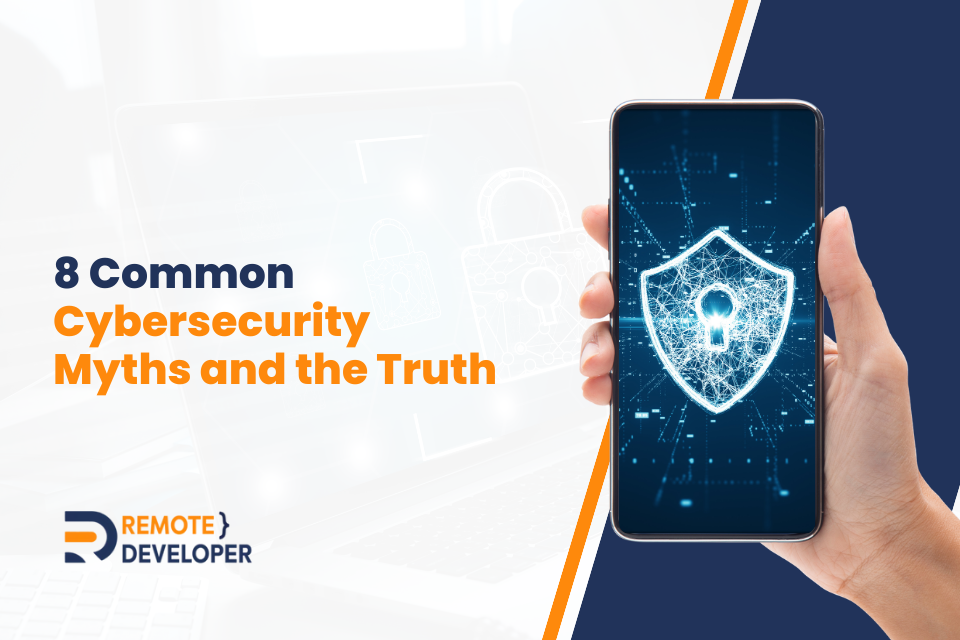In today’s hyper-connected digital landscape, cybersecurity has become a paramount concern for individuals, businesses, and organisations of all sizes. Yet, despite the growing awareness of cyber threats, many misconceptions and myths continue to circulate, often leading to inadequate protection and misguided decisions.
This article aims to shed light on eight common cybersecurity myths that persist in online security. By debunking these misconceptions, we hope to empower you with the knowledge to bolster your defences and confidently navigate the digital world. So, let’s dive in and unravel the truth behind these prevalent cybersecurity fallacies.
What is Cybersecurity?
Before we dive into debunking myths, let’s define cybersecurity. Cybersecurity, often called “information security” or “computer security,” is a comprehensive set of practices, technologies, and measures to safeguard digital systems, networks, devices, and data from unauthorised access, attacks, damage, or theft. It encompasses various technical, procedural, and human-focused measures to safeguard digital assets and information.
8 Common Cybersecurity Myths and the Truth
Now that you have a basic understanding of cybersecurity, it’s time to tackle the main topic. The realm of online threats and protection methods continues to evolve, and several common cybersecurity myths persist. These misconceptions can lead individuals and organisations down a path of false security and potential vulnerabilities.
So, to help you navigate this complex landscape, we’ll debunk eight of these prevalent cybersecurity myths, providing you with the facts and knowledge needed to fortify your digital defences and stay safe in the interconnected world.
Myth #1: “I’m not a target; hackers only target big businesses.”
One of the most pervasive cybersecurity myths is the belief that only large corporations are attractive targets for cyberattacks. Individuals and small businesses are just as susceptible to cyber threats. Hackers often cast a wide net, seeking out vulnerabilities wherever they may find them. Small organisations and individuals can be seen as low-hanging fruit due to potentially weaker cybersecurity defences.
Truth: Everyone can become a cyberattack target regardless of size or prominence. It is essential to take cybersecurity seriously, irrespective of your status. In fact, according to Verizon’s 2021 Data Breach Investigation Report, about 46% of cyber breaches are with small businesses with fewer than 1,000 employees.
Myth #2: “Antivirus software makes me invincible.”
Antivirus software is valuable for detecting and mitigating known malware and viruses. However, it is not a magical shield that makes you immune to all cyber threats. Cybercriminals continually develop new malware and tactics that antivirus programs may not immediately recognise.
Truth: While antivirus software is undoubtedly a crucial component of cybersecurity, it should complement other security measures such as regular software updates, firewalls, and user awareness training. Antivirus software alone is not enough. According to Krebs, on average, antivirus software is only 25% successful at detecting malware. When examining the statistics surrounding computer viruses and antivirus software, a trend emerges – malicious applications seem to be gaining the upper hand. Even the most advanced antivirus solutions struggle to keep up with the prevalence of “popular” malware.
Myth #3: “Complex passwords are enough to protect me.”
Many people believe that using complex passwords, such as strings of random characters, will guarantee their online security. While strong passwords are essential, they are only one part of the security equation.
Truth: Password complexity is essential. However, it can easily be obtained by hackers. Hackers employ various methods to get passwords, including phishing attacks and brute-force techniques. In fact, according to Digital Shadows, over 24 billion passwords were exposed in 2022 by hackers. Using unique passwords for different accounts and enabling two-factor authentication (2FA) wherever possible is equally vital.
Myth #4: “Public Wi-Fi networks are safe to use without precautions.”
In an era of constant connectivity, public Wi-Fi networks have become essential to our digital lives. Whether in a coffee shop, airport, or hotel, the convenience of free Wi-Fi access is undeniable. However, these networks are often inadequately secured, making them prime targets for hackers who can intercept data transmitted.
Truth: Many public Wi-Fi networks do not encrypt the data transmitted over their network. This means that information sent between your device and the web is vulnerable to interception by cybercriminals. Cybercriminals can exploit this vulnerability to secretly steal your data or implant malicious software on your devices without your knowledge. In fact, according to a study by Forbes, about 43% of individuals who used Public Wi-Fi had their security compromised.
Likewise, when using public Wi-Fi, always use a virtual private network (VPN) to encrypt your internet connection and avoid accessing sensitive information or conducting financial transactions on these networks.
Myth #5: “My data is secure in the cloud; I don’t need to worry.”
Cloud services have become integral to our digital lives, offering storage, email, and collaboration tools. Some people mistakenly assume that once data is in the cloud, it is impervious to security breaches. In reality, cloud services can be targeted by cybercriminals.
Truth: While cloud providers implement robust security measures, users still bear responsibility for their data’s security. According to the 2022 State of Cloud Security Report by Snyk, 80% of companies using cloud computing have experienced a breach incident in 2021.
As such, it’s essential to utilise robust authentication methods and encryption and regularly review your cloud security settings.
Myth #6: “I can spot phishing emails easily.”
Phishing emails are designed to deceive recipients into divulging sensitive information or downloading malicious software. While some phishing attempts are apparent, cybercriminals have become increasingly sophisticated in crafting convincing email campaigns.
Truth: Phishing scams still account for the most significant cause of data breaches, with nearly 36%, according to Verizon’s 2022 Data Breach Report. As such, always be cautious when opening emails, especially if they contain unexpected attachments that request sensitive information. Verify the sender’s identity and look for signs of phishing, such as misspelled URLs or unusual email addresses.
Myth #7: “Multi-factor authentication is too inconvenient.”
Some people avoid enabling multi-factor authentication (MFA) because they perceive it as inconvenient. They may believe entering a one-time code or using a security token is unnecessary extra effort.
Truth: MFA significantly enhances security by requiring something you know (your password) and something you have (a device or token). A 2020 survey conducted by Verizon revealed that a staggering 80% of cyberattacks revolved around compromised credentials or passwords. As a result, the consensus among cybersecurity experts leans towards Multi-Factor Authentication (MFA) as an indispensable initial barrier against cyberattacks.
Myth #8: “Cybersecurity is solely IT’s responsibility.”
Many individuals and employees assume that cybersecurity is solely the responsibility of their organisation’s IT department. They may believe that as long as they follow basic computer use guidelines, they are exempt from cybersecurity obligations.
Truth: Cybersecurity is a shared responsibility. While IT professionals play a critical role in securing systems and networks, every individual in an organisation must be vigilant and follow security protocols. Human error remains a significant factor in cyber incidents. In fact, according to a collaborative research effort between Stanford University’s Professor Jeff Hancock and security company Tessian, it was uncovered that a significant 88 percent of data breach occurrences stem from employee errors. A parallel study conducted by IBM Security places this figure even higher, at 95 percent.
5 Tips for Improving Cybersecurity
The previous section shows that the digital realm offers unprecedented vulnerabilities and threats. The risks are ever-present, from data breaches to identity theft and malware attacks, making it imperative to bolster our defences. Fortunately, the following essential information security tips and strategies can significantly improve your cybersecurity posture.
1. Strong Passwords and Authentication
Passwords are the first line of defence for your online accounts and digital assets. Creating strong and unique passwords is a fundamental step in safeguarding your information. A strong password typically includes uppercase and lowercase letters, numbers, and special characters. Avoid using easily guessable information like birthdays or common words.
Likewise, you can also consider using a reputable password manager to generate complex passwords and securely store them for easy access. With a password manager, you only need to remember one master password, reducing the risk of weak or duplicated passwords across multiple accounts.
Moreover, Multi-Factor Authentication (MFA) is another vital component of strong authentication, as mentioned earlier. MFA adds an extra layer of security by requiring at least two different verification forms before granting access. Enabling MFA wherever possible enhances your cybersecurity by making it significantly harder for unauthorised users to access your accounts.
2. Regular Software Updates
Software updates are more than just a minor inconvenience; they are essential for securing your digital environment. Operating systems, software applications, and antivirus programs release updates to address known vulnerabilities and weaknesses that hackers can exploit. Failing to update your software leaves you exposed to potential threats.
Set your devices and software to update when new patches are available automatically. This ensures that you are continually protected against the latest security risks. It’s a simple yet powerful step to improve your cybersecurity.
3. Beware of Phishing
As mentioned, phishing attacks remain among the most common and successful methods cybercriminals use to trick individuals into revealing sensitive information. These attacks often come in the form of deceptive emails, texts, or messages that appear to be from trusted sources. They may contain malicious links or attachments to steal your login credentials or spread malware.
To guard against phishing:
- Exercise caution when receiving unsolicited emails, especially those requesting personal or financial information.
- Verify the sender’s authenticity by double-checking email addresses and domains.
- Avoid clicking on suspicious links or downloading attachments from unknown sources.
- Be wary of urgent or threatening language in messages.
- Remember that reputable organisations will never ask for sensitive information via email or request immediate action without prior notice.
4. Secure Your Wi-Fi
Your home or workplace Wi-Fi network is a gateway to the digital world, and securing it is paramount for protecting your data. Start by setting a solid and unique password for your Wi-Fi network. Avoid using default passwords that are easily accessible to hackers. A strong Wi-Fi password is essential to prevent unauthorised access to your network.
In addition to this, it’s also essential to enable encryption on your network. The most advanced encryption standard for Wi-Fi is WPA3 (Wi-Fi Protected Access 3), which offers robust security features. Encryption ensures that the data transmitted between your devices and the Wi-Fi router is encoded, making it difficult for eavesdroppers to intercept and decipher.
5. Backup Your Data
Data loss can occur for various reasons, including cyberattacks, hardware failures, or accidental deletions. To safeguard your valuable information, backing up your data regularly is essential. A robust backup strategy involves making copies of your critical files and storing them in a separate location or the cloud.
Conclusion
Dispelling common myths is a significant step toward enhanced digital protection in cybersecurity. There is no one-size-fits-all solution in cybersecurity. Everyone must stay informed of new trends, adopt best practices, and foster a culture of security awareness.
In the end, debunking these myths is only the first step. The key to effective cybersecurity lies in proactive measures, constant learning, and remaining vigilant in the face of ever-changing threats. Your digital safety is a journey, not a destination.
Ready to bolster your cybersecurity knowledge and practices? Stay informed and secure in the digital world. Contact a remote developer today to assess and improve your online security.

